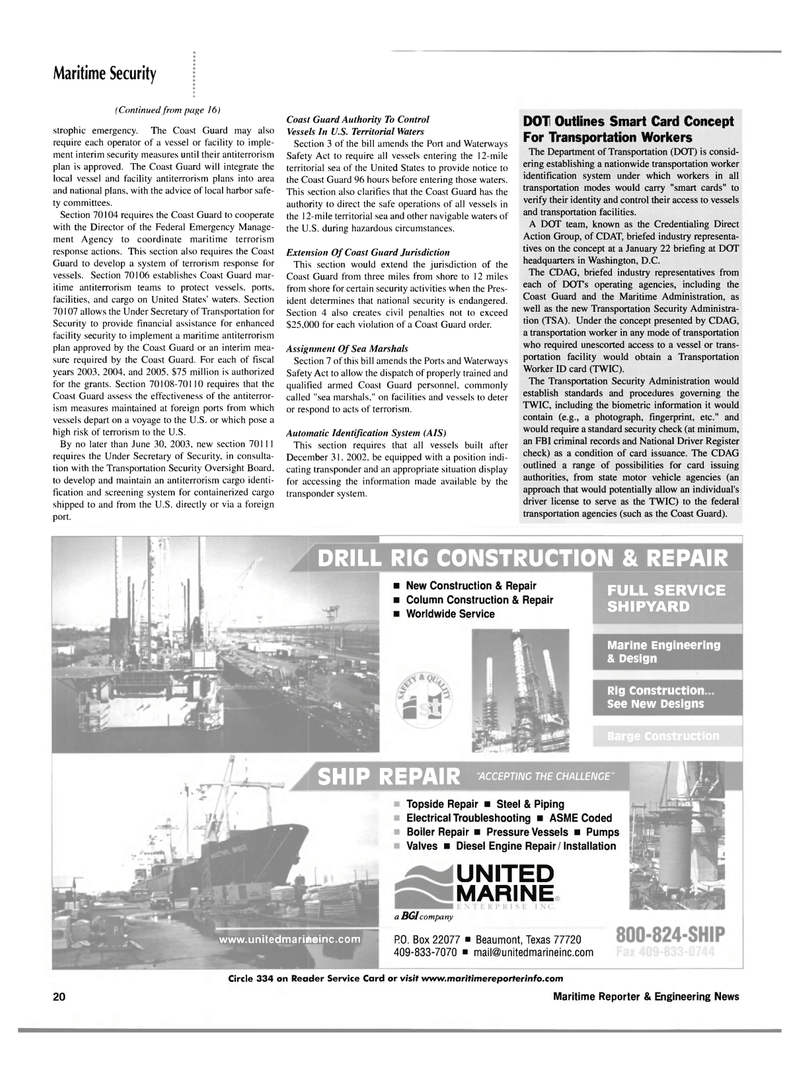
Page 18: of Maritime Reporter Magazine (April 2002)
Read this page in Pdf, Flash or Html5 edition of April 2002 Maritime Reporter Magazine
Maritime Security (Continued from page 16) strophic emergency. The Coast Guard may also require each operator of a vessel or facility to imple- ment interim security measures until their antiterrorism plan is approved. The Coast Guard will integrate the local vessel and facility antiterrorism plans into area and national plans, with the advice of local harbor safe- ty committees.
Section 70104 requires the Coast Guard to cooperate with the Director of the Federal Emergency Manage- ment Agency to coordinate maritime terrorism response actions. This section also requires the Coast
Guard to develop a system of terrorism response for vessels. Section 70106 establishes Coast Guard mar- itime antiterrorism teams to protect vessels, ports, facilities, and cargo on United States' waters. Section 70107 allows the Under Secretary of Transportation for
Security to provide financial assistance for enhanced facility security to implement a maritime antiterrorism plan approved by the Coast Guard or an interim mea- sure required by the Coast Guard. For each of fiscal years 2003, 2004, and 2005, $75 million is authorized for the grants. Section 70108-70110 requires that the
Coast Guard assess the effectiveness of the antiterror- ism measures maintained at foreign ports from which vessels depart on a voyage to the U.S. or which pose a high risk of terrorism to the U.S.
By no later than June 30, 2003, new section 701 1 1 requires the Under Secretary of Security, in consulta- tion with the Transportation Security Oversight Board, to develop and maintain an antiterrorism cargo identi- fication and screening system for containerized cargo shipped to and from the U.S. directly or via a foreign port.
Coast Guard Authority To Control
Vessels In U.S. Territorial Waters
Section 3 of the bill amends the Port and Waterways
Safety Act to require all vessels entering the 12-mile territorial sea of the United States to provide notice to the Coast Guard 96 hours before entering those waters.
This section also clarifies that the Coast Guard has the authority to direct the safe operations of all vessels in the 12-mile territorial sea and other navigable waters of the U.S. during hazardous circumstances.
Extension Of Coast Guard Jurisdiction
This section would extend the jurisdiction of the
Coast Guard from three miles from shore to 12 miles from shore for certain security activities when the Pres- ident determines that national security is endangered.
Section 4 also creates civil penalties not to exceed $25,000 for each violation of a Coast Guard order.
Assignment Of Sea Marshals
Section 7 of this bill amends the Ports and Waterways
Safety Act to allow the dispatch of properly trained and qualified armed Coast Guard personnel, commonly called "sea marshals," on facilities and vessels to deter or respond to acts of terrorism.
Automatic Identification System (AIS)
This section requires that all vessels built after
December 31, 2002, be equipped with a position indi- cating transponder and an appropriate situation display for accessing the information made available by the transponder system.
DOT Outlines Smart Card Concept
For Transportation Workers
The Department of Transportation (DOT) is consid- ering establishing a nationwide transportation worker identification system under which workers in all transportation modes would carry "smart cards" to verify their identity and control their access to vessels and transportation facilities.
A DOT team, known as the Credentialing Direct
Action Group, of CDAT, briefed industry representa- tives on the concept at a January 22 briefing at DOT headquarters in Washington, D.C.
The CDAG, briefed industry representatives from each of DOT's operating agencies, including the
Coast Guard and the Maritime Administration, as well as the new Transportation Security Administra- tion (TSA). Under the concept presented by CDAG, a transportation worker in any mode of transportation who required unescorted access to a vessel or trans- portation facility would obtain a Transportation
Worker ID card (TWIC).
The Transportation Security Administration would establish standards and procedures governing the
TWIC, including the biometric information it would contain (e.g., a photograph, fingerprint, etc." and would require a standard security check (at minimum, an FBI criminal records and National Driver Register check) as a condition of card issuance. The CDAG outlined a range of possibilities for card issuing authorities, from state motor vehicle agencies (an approach that would potentially allow an individual's driver license to serve as the TWIC) to the federal transportation agencies (such as the Coast Guard).
DRILL RIG CONSTRUCTION & REPAIR
FULL SERVICE
SHIPYARD
Marine Engineering & Design
Rig Construction
See New Designs
Barge construction
SHIP RE PA IR "ACCEPTING THE CHALLENGE www.unitedmariileinc.com • New Construction & Repair • Column Construction & Repair • Worldwide Service
Topside Repair • Steel & Piping
Electrical Troubleshooting • ASME Coded
Boiler Repair • Pressure Vessels • Pumps
Valves • Diesel Engine Repair/Installation
UNITED MARINE a BGI company
R0. Box 22077 • Beaumont, Texas 77720 409-833-7070 • [email protected]
Circle 334 on Reader Service Card or visit www.maritimereporterinfo.com 20 Maritime Reporter & Engineering News

 17
17

 19
19
